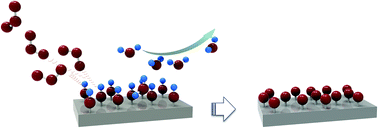Growth modulation of atomic layer deposition of HfO2 by combinations of H2O and O3 reactants†
Abstract
Atomic layer deposition (ALD) is a thin film deposition technique based on self-saturated reactions between a precursor and reactant vacuum conditions. A typical ALD reaction consists of the first half-reaction of the precursor and the second half-reaction of the counter reactant, in which the terminal groups on the surface change after each half-reaction. In this study, the effects of counter reactants on the surface termination and growth characteristics of ALD HfO2 thin films formed on Si substrates using tetrakis(dimethylamino)-hafnium (TDMAH) as a precursor were investigated. Two counter reactants, H2O and O3, were individually employed, as well as in combination with consecutive exposure by H2O–O3 and O3–H2O. The film growth behaviors and properties differed when the sequence of exposure of the substrate to the reactants was varied. Based on X-ray photoelectron spectroscopy (XPS) and density functional theory (DFT) simulation, the changes are attributed to the effects of the surface terminations formed from different counter reactant combinations. The knowledge from this work could provide insight for precisely tuning the growth and properties of ALD films.

- This article is part of the themed collection: Spotlight Collection: Atomic and Molecular Layer Deposition


 Please wait while we load your content...
Please wait while we load your content...